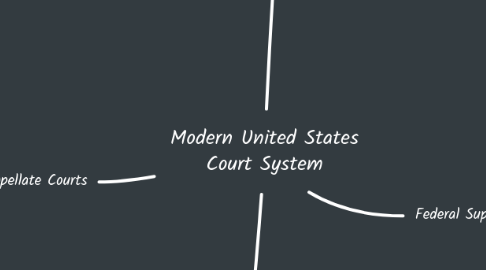
1. Federal Appellate Courts
1.1. Decisions can Be:
1.1.1. Affirmed:Conforming the district court decision
1.1.2. Reversed: Overturning the district court decision
1.1.3. Remanded:Sent back to the lower court for reconsideration
1.2. Losing side may appeal to the Supreme Court
1.3. 13 Court of Appeals
1.4. 11 have jurisdiction regionally based "circuits" one has jurisdiction in the District of Columbia and the last handles cases of international trade and patent law.
2. Federal Supreme Court
2.1. Upon arrival the Supreme Court may...
2.1.1. refuse to hear the case
2.1.2. Four justices must decide to hear the case (relys on the rule of four)
2.1.2.1. case must present a federal question
2.1.2.2. if the case resolves conflict over a law or previous rulings
2.1.2.3. preference of the justices can play a role
2.1.2.4. there could be an amicus curiae brief - Amicus Curiae Brief is when the court brings in an individual or an organization to assist in the case.
2.1.3. If accepted...
2.1.3.1. a writ of certiorari -a request for the Supreme Court to order for the record from a lower court
2.1.3.2. A stare decisis - allows a previous decision to stand in avoidance of making a new precedent.
2.1.3.2.1. A precedent is made - a judicial decision that acts as a base for the future.
2.1.4. Judicial Decision
2.1.4.1. Majority Opinion
2.1.4.1.1. 5 or more of the justices out of the 9 agree to convict
2.1.4.2. Dissenting Opinion
2.1.4.2.1. Disagrees with majority opinion
2.1.4.3. Concurring Opinion
2.1.4.3.1. when the judge agrees, but with a different view point or a different opinion
2.1.4.4. Plurality Opinion
2.1.4.4.1. When there are not enough judges to make majority of the court.
3. State Courts
3.1. Handle a majority of the court cases in the United States. Handle both criminal and civil cases. Have a system of trial courts that does most of a state's judiciary
3.2. System of Specialized Courts
3.2.1. traffic violations
3.2.2. family disputes
3.2.3. small claims
3.3. Each state has at least one state supreme court (acts as the highest court in that state's system and as the final level of appeal)
3.3.1. Select Groups of cases may proceed to the federal judiciary from the highest state court of appeals.
3.3.1.1. These cases come to question something under the Constitution.
3.4. System of Trial Courts
3.4.1. State judiciary
3.4.2. handles cases arising state's laws
3.4.3. possesses original jurisdiction.
3.5. More than half of the states have an intermediate system of appellate courts that operate with appellate jurisdiction.
4. Federal District Courts
4.1. Most cases end here by...
4.1.1. settlement
4.1.2. losing party decides not to appeal
